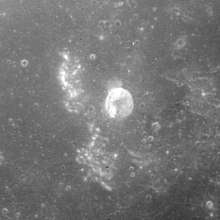Wallach (crater)
Wallach is a tiny lunar impact crater located in the eastern Mare Tranquillitatis. It was named after German chemist and Nobel laureate Otto Wallach.[1] It is a circular, bowl-shaped feature with a negligible interior floor; the inner walls just slope down to the midpoint of the crater. Wallach is located to the northeast of the crater Maskelyne, near some low ridges in the lunar mare. It was previously identified as Maskelyne H before being given a name by the IAU.
 Apollo 15 mapping camera image | |
| Coordinates | 4.9°N 32.3°E |
|---|---|
| Diameter | 6 km |
| Depth | 1.1 km |
| Colongitude | 328° at sunrise |
| Eponym | Otto Wallach |



An unusual and apparently unnamed elongate crater about 2 km x 5 km in size and about 44 km east of Wallach was the subject of a landmark tracking exercise on Apollo 8 in December 1968.[2] The feature was photographed repeatedly from its emergence on the horizon to after the Command Module had passed directly over it.
References
- "Wallach (crater)". Gazetteer of Planetary Nomenclature. USGS Astrogeology Research Program.
- Apollo 8 Flight Journal, Photography Index, 70-mm Magazine E, photos AS08-13-2271 to AS08-13-2309
- Andersson, L. E.; Whitaker, E. A. (1982). NASA Catalogue of Lunar Nomenclature. NASA RP-1097.CS1 maint: ref=harv (link)
- Bussey, B.; Spudis, P. (2004). The Clementine Atlas of the Moon. New York: Cambridge University Press. ISBN 978-0-521-81528-4.CS1 maint: ref=harv (link)
- Cocks, Elijah E.; Cocks, Josiah C. (1995). Who's Who on the Moon: A Biographical Dictionary of Lunar Nomenclature. Tudor Publishers. ISBN 978-0-936389-27-1.CS1 maint: ref=harv (link)
- McDowell, Jonathan (July 15, 2007). "Lunar Nomenclature". Jonathan's Space Report. Retrieved 2007-10-24.CS1 maint: ref=harv (link)
- Menzel, D. H.; Minnaert, M.; Levin, B.; Dollfus, A.; Bell, B. (1971). "Report on Lunar Nomenclature by the Working Group of Commission 17 of the IAU". Space Science Reviews. 12 (2): 136–186. Bibcode:1971SSRv...12..136M. doi:10.1007/BF00171763.CS1 maint: ref=harv (link)
- Moore, Patrick (2001). On the Moon. Sterling Publishing Co. ISBN 978-0-304-35469-6.CS1 maint: ref=harv (link)
- Price, Fred W. (1988). The Moon Observer's Handbook. Cambridge University Press. ISBN 978-0-521-33500-3.CS1 maint: ref=harv (link)
- Rükl, Antonín (1990). Atlas of the Moon. Kalmbach Books. ISBN 978-0-913135-17-4.CS1 maint: ref=harv (link)
- Webb, Rev. T. W. (1962). Celestial Objects for Common Telescopes (6th revised ed.). Dover. ISBN 978-0-486-20917-3.CS1 maint: ref=harv (link)
- Whitaker, Ewen A. (1999). Mapping and Naming the Moon. Cambridge University Press. ISBN 978-0-521-62248-6.CS1 maint: ref=harv (link)
- Wlasuk, Peter T. (2000). Observing the Moon. Springer. ISBN 978-1-85233-193-1.CS1 maint: ref=harv (link)
External links
- LTO-61D1 Wallach, Lunar Topographic Orthophotomap (LTO) Series